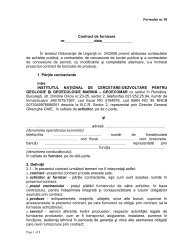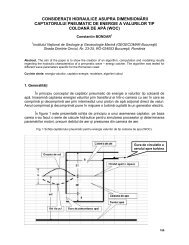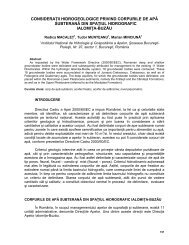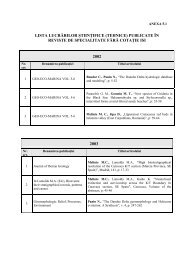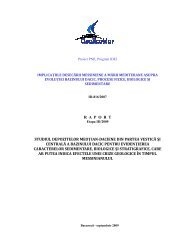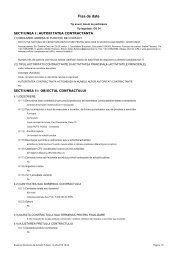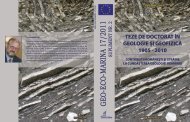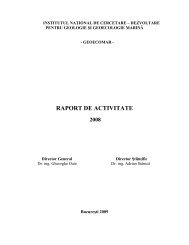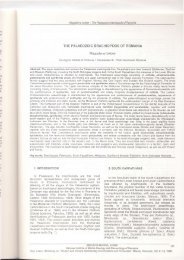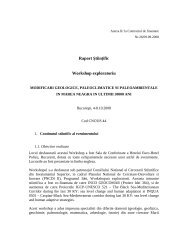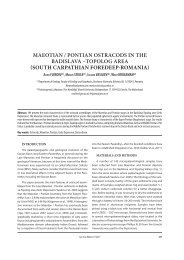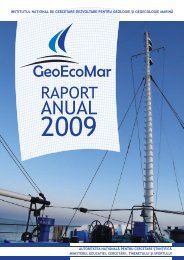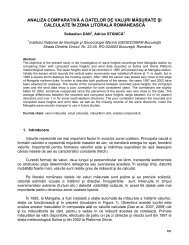DACIAN BASIN - GeoEcoMar
DACIAN BASIN - GeoEcoMar
DACIAN BASIN - GeoEcoMar
Create successful ePaper yourself
Turn your PDF publications into a flip-book with our unique Google optimized e-Paper software.
1.2. Stratigraphy<br />
poral limits of these “brackish stages” are different from one area to another. The<br />
ecological facies pertaining to a brackish stage may occur in different space units<br />
or time intervals. The best example is that of the “Pontian type” fauna or “Sarmatian<br />
type” fauna from the Mediterranean area, faunas which have nothing in common<br />
with the Paratethian Pontian or Sarmatian faunal assemblages. These aspects could<br />
also create difficulties for the construction of the magnetostratigraphic scales.<br />
1.2.2. Toward a reliable chronostratigraphic and geochronologic framework<br />
of the Dacian Basin 1<br />
Many contributions of Romanian and/or foreign researchers refer to the ages of the<br />
Dacian Basin sedimentary deposits. Still, an unique (and unanimously accepted)<br />
chronostratigraphic and geochronologic framework has not yet been achieved<br />
(Fig.1.5). To reach a high-resolution dating of the Miocene and Pliocene (sub)stage<br />
boundaries, various new techniques have been integrated with the traditional biostratigraphy,<br />
principally magnetostratigraphy, astrochronology and cyclostratigraphy.<br />
Reliable sampling techniques, sophisticated paleomagnetic laboratories, along<br />
with an increasing number of data analysis methods and more refined criteria<br />
were developed worldwide to retrieve the paleogeomagnetic fossile, i.e. the primary<br />
Natural Remanent Magnetisation (NRM) component (Characteristic Remanent<br />
Magnetisation/ChRM, isolated in laboratory). This magnetic signal, commonly<br />
weak in the sedimentary deposits in which it is printed/”frozen”, may be affected by<br />
noise from a number of perturbation processes or may be obscured subsequently<br />
to rock formation, along their geological and geochemical history.<br />
A breakthrough in age determination has been the astronomical dating (Hilgen,<br />
1991, 1994, Hilgen et. al., 1995, Berggren et al., 1995, Krijgsman, 1996). An Astronomically<br />
calibrated (Polarity) Time Scale [A(P)TS] has been constructed (first, for the<br />
Pliocene – Pleistocene time interval; Lourens et al., 1996), and even incorporated in<br />
the existing (very usable) standard Geomagnetic Polarity Time Scale (GPTS) of Cande<br />
and Kent (1995; CK95). Since 2004, the Astronomical Tuned Neogene Time Scale<br />
(ATNTS2004; Lourens et al., 2004), characterised by an unprecedented resolution<br />
and accuracy, is in use.<br />
In this shortly defined context, the geological time scales (GTS) in figure 1.5,<br />
particularly the ages assigned to the chronostratigraphic boundaries, should be<br />
carefully considered before adopting one of them. To compare and evaluate these<br />
GTS’s (models A, B, C, D) with the intention of assuming a (reliable) version for<br />
the Dacian Basin (possibly, a composite GTS), at least the following major aspects<br />
should be taken into consideration:<br />
1 Author: Sorin-Corneliu Rădan<br />
23



